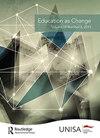辅助英语第一附加语言课堂批判性阅读理解的相互依存读写模式
IF 1
4区 教育学
Q3 EDUCATION & EDUCATIONAL RESEARCH
引用次数: 0
摘要
为了帮助在课堂上遇到读写困难,特别是批判性阅读困难的众多南非学习者,已经进行了各种尝试。尽管已经开发了一些以阅读能力为重点的批判性读写模式来缓解南非的阅读理解危机,但正如国际阅读能力研究进展报告所显示的那样,南非学习者的阅读理解能力仍然很差。本文主张在课堂上注重批判性阅读理解。在回顾批判性读写能力的四种资源模型和批判性读写能力的相互依赖模型的基础上,研究人员提出了一种新的读写能力辩论模型,即批判性阅读相互依赖读写能力模型(Critical Reading interdependence Literacy Model,简称CRILM),该模型设计用于学校层面,适用于四年级及以上的学生。CRILM基于一个教学框架,促进教育者、学习者、文本和作者之间的参与-互动-相互依赖的关系。通过文本和作者,学习者将能够在英语第一附加语言课堂中开始批判性的洞察力和社会知识的发展。这一新模式以教育者、学习者、文本和作者及其与现实的关系为中心,假设所有参与者在阅读过程中相互作用和相互依存,以促进课堂批判性阅读理解的成功发展。本文章由计算机程序翻译,如有差异,请以英文原文为准。
An Interdependent Literacy Model to Assist with Critical Reading Comprehension in the English First Additional Language Classroom
Various attempts have been made to assist the multitude of South African learners who experience literacy challenges, particularly critical reading challenges, in the classroom. Although a number of critical literacy models that focus on reading literacy have been developed to alleviate the reading comprehension crisis in South Africa, poor reading comprehension continues to prevail among South African learners, as shown in the Progress in International Reading Literacy Study reports. This article argues for a focus on critical reading comprehension in the classroom. Based on a review of the Four Resources Model of Critical Literacy and the Interdependent Model of Critical Literacy, the researchers propose a new model to the literacy debate, the Critical Reading Interdependent Literacy Model (CRILM), which is designed to be used at school level and is suitable to be used from Grade 4 and beyond. CRILM is based on an instruction and learning framework that promotes a participatory-interactive-interdependent relationship between educators, learners, the text, and the author. Through the text and author, learners will be able to initiate critical insight and societal knowledge development from within the English First Additional Language classroom. Centred on the educator, the learners, the text, and the author, as well as their relation to reality, this proposed new model hypothesises the interaction and interdependence of all the participants during the reading process for the successful development of classroom critical reading comprehension.
求助全文
通过发布文献求助,成功后即可免费获取论文全文。
去求助
来源期刊

Education As Change
EDUCATION & EDUCATIONAL RESEARCH-
CiteScore
1.40
自引率
0.00%
发文量
29
审稿时长
24 weeks
期刊介绍:
Education as Change is an accredited, peer reviewed scholarly online journal that publishes original articles reflecting critically on issues of equality in education and on the ways in which educational practices contribute to transformation in non-formal, formal and informal contexts. Critique, mainly understood in the tradition of critical pedagogies, is a constructive process which contributes towards a better world. Contributions from and about marginalised communities and from different knowledge traditions are encouraged. The articles could draw on any rigorous research methodology, as well as transdisciplinary approaches. Research of a very specialised or technical nature should be framed within relevant discourses. While specialised kinds of research are encouraged, authors are expected to write for a broader audience of educational researchers and practitioners without losing conceptual and theoretical depth and rigour. All sectors of education are covered in the journal. These include primary, secondary and tertiary education, adult education, worker education, educational policy and teacher education.
 求助内容:
求助内容: 应助结果提醒方式:
应助结果提醒方式:


